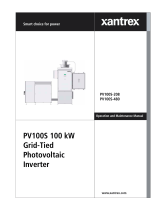
www.ti.com
2
SPRAC85–May 2017
Submit Documentation Feedback
Copyright © 2017, Texas Instruments Incorporated
Bidirectional DC-AC Solution For Solar Application System, Based on the
TMS320F28035 MCU
Contents
1 Introduction ................................................................................................................... 3
2 System Specification ........................................................................................................ 3
3 MCU Use Overview ......................................................................................................... 4
4 Hardware Design ............................................................................................................ 5
5 Firmware Design ........................................................................................................... 12
6 Final Product Performance................................................................................................ 20
7 Related Documentation.................................................................................................... 22
List of Figures
1 System Overview Block..................................................................................................... 3
2 DC-AC Circuit Structure .................................................................................................... 5
3 Circuit Analysis for Arm On................................................................................................. 6
4 Circuit Analysis for Arm Off................................................................................................. 6
5 3-Phase Bridge Driver Circuit.............................................................................................. 7
6 Boost Driver Circuit.......................................................................................................... 8
7 Voltage Signal Sample Circuit ............................................................................................. 9
8 Current Signal Sample Circuit............................................................................................ 10
9 AC Waveform Frequency Detection Circuit............................................................................. 11
10 DC-AC Equivalent.......................................................................................................... 12
11 Current and Voltage Phase Relationship ............................................................................... 12
12 Software Main Process Flow ............................................................................................. 13
13 Current Closed Loop Flow ................................................................................................ 14
14 Lap Conversion Diagram.................................................................................................. 15
15 Closed-Loop Diagram ..................................................................................................... 15
16 Simplified Control Loop.................................................................................................... 15
17 Current Loop Controller Analysis......................................................................................... 16
18 V-I Curves for Solar Cell .................................................................................................. 16
19 DC-DC Control Loop Diagram............................................................................................ 17
20 MPPT Algorithm Flow ..................................................................................................... 18
21 Current and Voltage Waveform in PFC Mode.......................................................................... 20
22 Current and Voltage Waveform in Translation Mode.................................................................. 21
23 Current and Voltage Waveform in Inverter Mode...................................................................... 21
List of Tables
1 System Specification........................................................................................................ 3
2 MCU Pin Assignment........................................................................................................ 4
Trademarks
Piccolo is a trademark of Texas Instruments.
All other trademarks are the property of their respective owners.
























